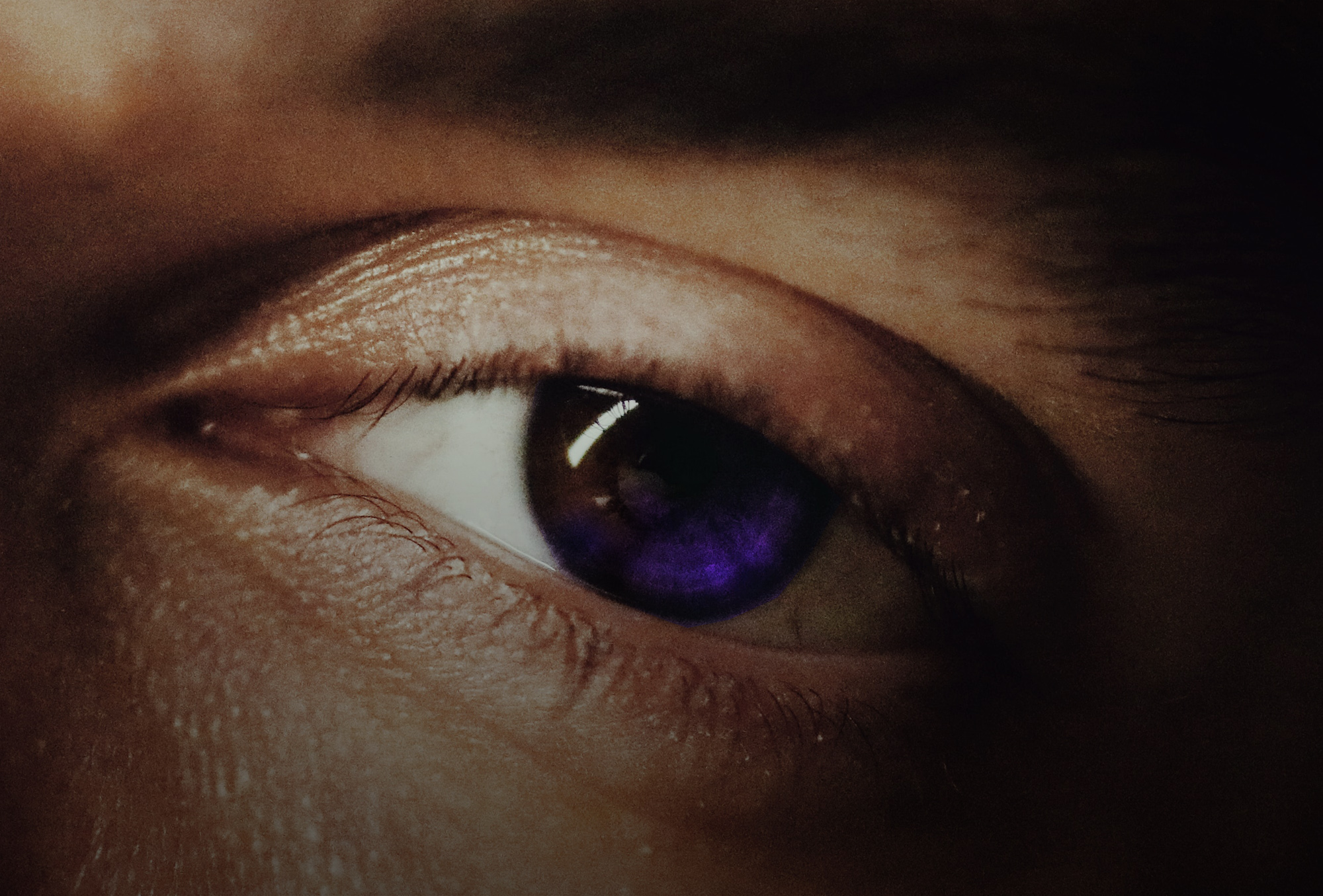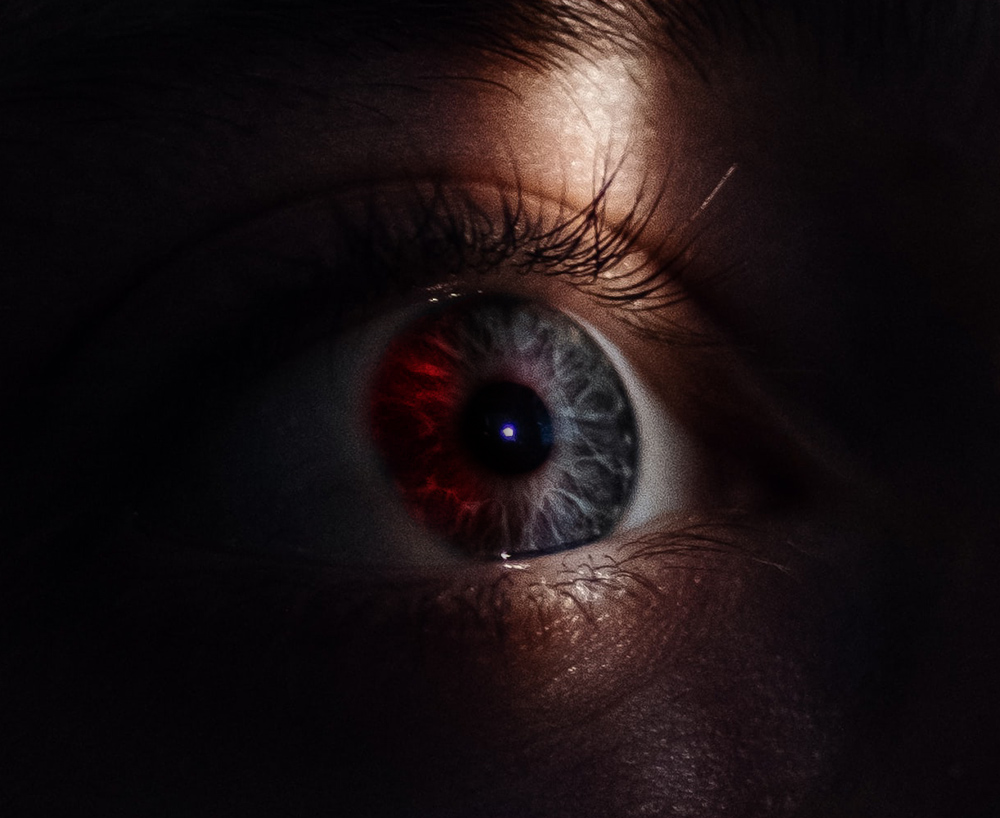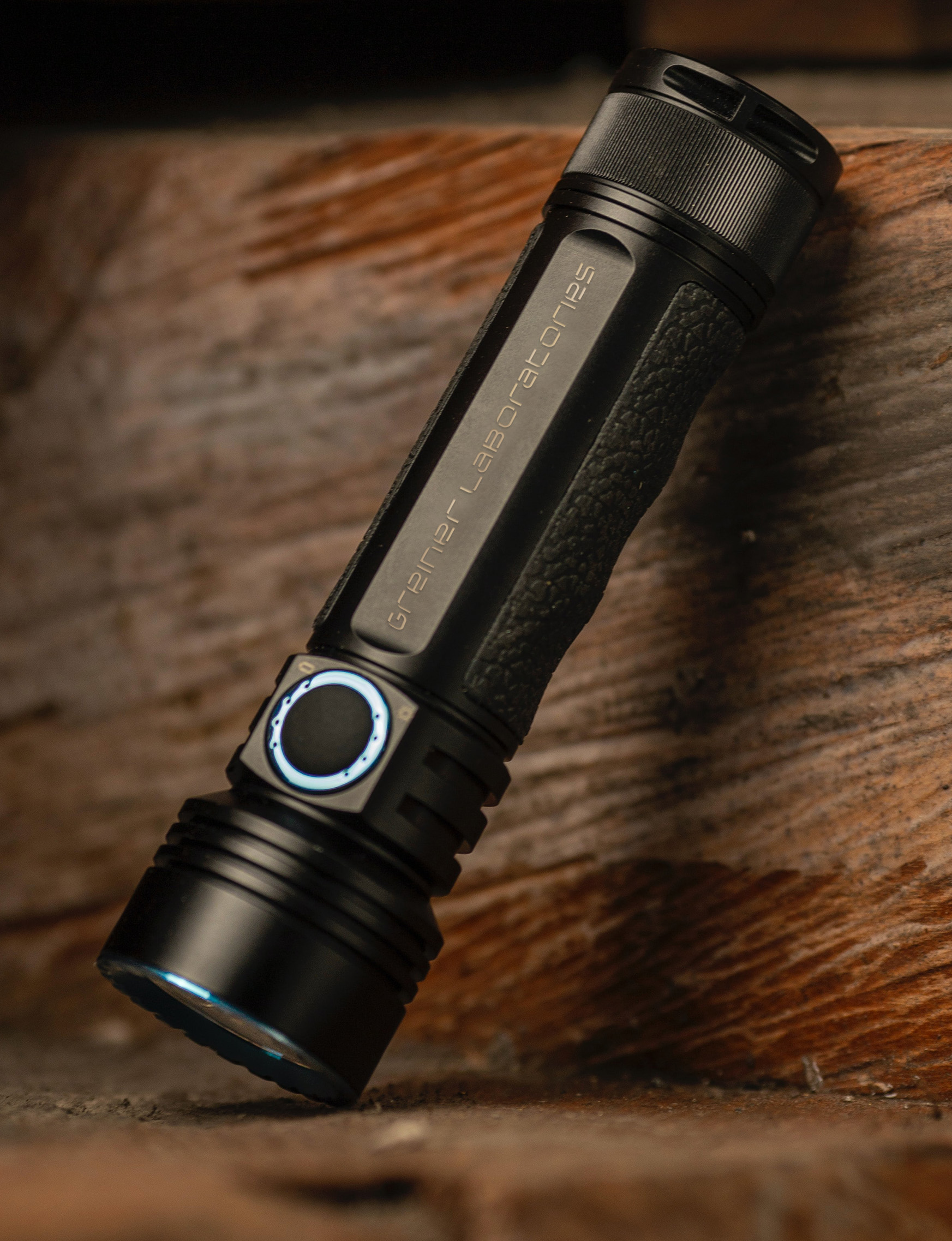Iris Wavelength
DWEL torches and IW detectors
Under certain frequencies of ultraviolet radiation, called "the detection wavelength," the human body will emit monochromatic light with a wavelength that is unique to each individual. The phenomenon is most detectable when UV light is shone into the eye due to the curvature of the lens and the absorption of light by aqueous humor, giving the irises a sheen of vivid colour. Even so, it can only be seen with the naked eye in conditions of very low light.
The eye of an individual of the Light under the detection light
The eye of an individual of the Under under the detection light
This wavelength will usually correspond to light within the visible frequency. In some rare cases, the emitted light will be below 400 nm, pertaining to those of the Light or the Flesh. Iris wavelengths above 700 nm are also possible, emitted by those of the Mysteries. Notably, the iris wavelength (IW) colour is complementary to the colour of the light produced by threads during reorientation. For example, those of the Flesh tend to reflect light with a wavelength corresponding to green, purple for the Light etc.
Utility
Iris wavelength is commonly used to identify a person, long before an accurate detector was built, judging by the naked eye. This is a fairly recent invention and the detection wavelength was discovered inadvertently discovered by Anzo Blum. However, because multiple people can bear the same iris wavelength once rounded up, it is often used in conjunction with traditional methods of identification, such as fingerprinting, ear print analysis or identification documents. Using a very accurate detector, nearly all iris wavelengths are unique. The significance of iris-wavelength identification lies in the fact that the wavelength cannot be faked or altered, at least not with current technologies. It is possible for those of the Flesh to alter their fingerprints, rendering biometrics useless, but their iris-wavelength will remain green. Of course, low-quality detectors can be fooled with specially-designed contact lenses, but the Houses do not use those.
Types of detectors
Using the naked eye to discern a person's iris wavelength is very quick and cheap but not very accurate and not available in many situations.- One step above no equipment is a specially-designed torch and a pair of human eyes (that are not being tested on). The torch emits light of the detection frequency but requires the human to judge the colour of the light. It is faster and cheaper than a detector. The torch usually works as a normal torch and is provided to Isordi armies.
- A low- to mid-grade detector can report the wavelength to a decent decimal place but can be fooled and create errors etc. Usually battery-powered and most commonly used on the field. Pretty cheap to maintain, about 2-6 years of usage.
- High-grade detectors are large, bulky machines that have to be plugged in. You sit and stare into a little screen, like getting an eye test. They go up to far too many decimal places but usually can take in normal biometrics as well. Far too expensive to buy and maintain by any other than the rich (and paranoid) houses.
A DWEL torch with an aluminium casing
Regardless of the type of detector used, the test is painless. However, some report mild stinging in their eyes, much like walking out of a dark room into an open area. The pupils do not dilate during this process, however, as the irises do not respond to light outside the visible spectrum.Manufacturing
Though UV-A LEDs are not difficult to manufacture, very few companies have the technological capability to produce the filter fluid that is required in DWEL torches to block out unwanted wavelengths. The fluids are sold for a high profit to the numerous companies that produce the outer casing and assemble the torch. A similar arrangement occurs for mid-grade IW detectors, where the optical filter is either produced by Nikos or one of its few competitors and sent to a number of companies who build the actual detectors. High-grade detectors are produced entirely "in-house," with only the most fundamental parts bought from external contractors to ensure that the machines are not compromised. While Greiner Laboratories are making headway into the development of high-grade IW detectors, House Airi remains the largest provider.
Social Impact
The manufacturing of filter fluid produces byproducts of highly toxic gases that are often untreated before being released into the atmosphere, affecting the health of local residents. Many regions in the northeast of the Heartlands suffer from pollution from these factories, which can lead to smog and increased acidity in rain and surrounding bodies of water. Though some are connected to the electric grid, the factories are mainly powered by nuon induction, producing electrical energy via local threads, which can cause a critical increase in ambience if unregulated.
The IW detectors themselves have allowed for increased security, but it has increased segregation between people of different affinities as they are now easier to identify. There are towns in Isord that refuse to let people with a certain wavelength in, even if their IW colour does not correspond to the traditional elemental colour. Rigged detectors produce inaccurate results that can lead to the wrong suspect being blamed for a crime.
Access & Availability
Detection wave emitting light (DWEL) torches and low-grade detectors are not expensive or complicated to produce, but as an item of very specific use, they are not typically available to the consumer market. Rather, DWELL torches need to be ordered from one of the companies selling security and identification equipment. They are readily available in the Isordi black market, though their quality is questionable. Though they also produce DWEL torches and lower-grade detectors, House Airi boasts high-grade detectors, specialising in the very large and heavy but accurate machines which they invented or at least sponsored the invention of. Only the Great Houses and the largest of free companies can afford these for situations requiring maximum security. Our institute was gifted with such a machine by our patron, House Sauda (or we did until one of the researchers broke it apart and the thing self-destructed). The construction of the detectors are kept a closely guarded secret, lest someone figure out a way to fool them, and the Airi manufacturing facilities in the Yōsune Archipelago are said to be one of the most secure locations on Ereya.
Complexity
DWEL torches are fairly simple in construction, though requires a more powerful power source than the average torch's battery. The standard materials used are aluminium or glass-reinforced epoxies, but anything ranging from cheap polystyrene to polished titanium is available in the market. The light source itself is a type of UV-A light-emitting diode contained within filter fluid that blocks visible light and other wavelengths besides the required one. Light is shone through a lens of deep blue-violet silicate glass and focused by a parabolic reflector made of glass or polished metal, or a light tube if the torch depends on total internal refraction.
The complexity of an IW detector depends entirely on its quality. Cheap detectors are little more than DWEL torches strapped to an optical sensor and a filter made from materials such as panayiotis, the brand name of Nikos' temperature-resistant, high silica glass. The components of Airi IW detectors are well-kept secrets, but it is likely that an exciplex laser is used.
Discovery
The discovery of the detection wavelength or detection frequency was something of a blunder on the part of Anzo Blum, a Yōsuner inventor, philosopher, ornithologist, artist and musician, and a fortunate stroke of serendipity for his patron, Lord Hinata of House Airi (of the Fauna). Blum's intention was to find a treatment for eseric cancer, a form of malignant tissue growth that is a partial effect of ambience corrosion that his mother, Miu Blum, suffered from. She had been a courtesan for House Valya (of the Heat) for many years and her exposure to high ambience conditions was likely the cause of her condition. Miu's health was sustained by the House's red nurse as eseric cancer cannot be cured. However, following the Valyas' bankruptcy and subsequent liquidations of their mines and forges in the Yōsune Archipelago, she was unable to afford the service of the Red Veil. During this time, Anzo had just graduated from the Institute and was picked up by Lord Hinata, who was not sympathetic to Blum's troubles. Still working on the lord's projects, Anzo Blum spent every other hour of the day with light and lasers which were known to react with the cancer cells, eventually coming across the detection wavelength. By this time, Lord Airi stopped his patronage, claiming Blum's performance to be was lacking and Miu Blum died not soon after. Not long after, Lord Airi realised the significance of the detection wavelength and commissioned projects that resulted in the first iris-wavelength detector, named the Hinata I and shipped to Houses from the north of Isord to the cold wastes of Asura, amassing a huge fortune for the Airis
Remove these ads. Join the Worldbuilders Guild













Comments